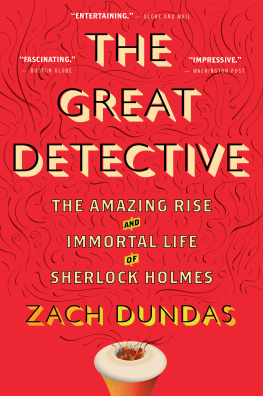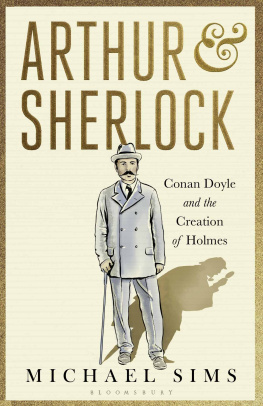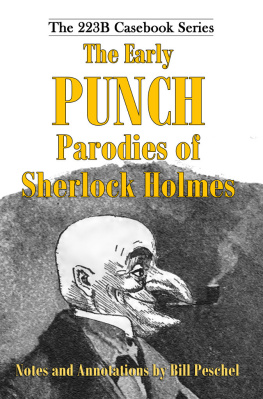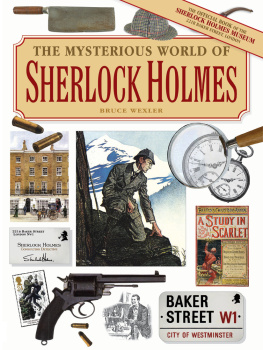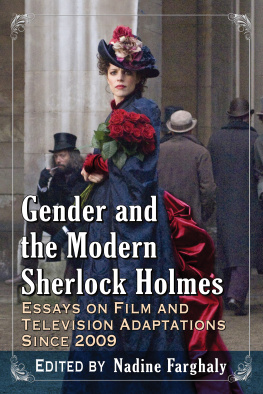First Mariner Books edition 2016
Copyright 2015 by Zach Dundas
ALL RIGHTS RESERVED
For information about permission to reproduce selections from this book, write to or to Permissions, Houghton Mifflin Harcourt Publishing Company, 3 Park Avenue, 19th Floor, New York, New York 10016.
www.hmhco.com
Library of Congress Cataloging-in-Publication Data
Dundas, Zach.
The great detective : the amazing rise and immortal life of Sherlock Holmes / Zach Dundas.
pages cm
ISBN 978-0-544-21404-0 (hardback) ISBN 978-0-544-22020-1 (ebook)
ISBN 978-0-544-70521-0 (pbk.)
1. Doyle, Arthur Conan, 18591930CharactersSherlock Holmes. 2. Holmes, SherlockInfluence. 3. Detective and mystery stories, EnglishHistory and criticism. 4. Private investigators in literature. 5. Dundas, Zach. I. Title.
PR 4624. D 86 2015
823'.809dc23
2014039684
v2.0516
Cover design by Laserghost
The spot illustrations are from the following sources: : Scan This Book, compiled by John Mendenhall.
C.E.M.
How came he to have so singular a companion?
C.V.D.
The stormy petrel of crime
G.C.H.
The Secret Weapon
Reality is not the subject nor the object of true art which creates its own special reality having nothing to do with the average reality perceived by the communal eye.
VLADIMIR NABOKOV , PALE FIRE
There are two kinds of truth: the truth that lights the way and the truth that warms the heart. The first of these is science, and the second is art. Neither is independent of the other or more important than the other. Without art science would be as useless as a pair of high forceps in the hands of a plumber. Without science art would become a crude mess of folklore and emotional quackery. The truth of art keeps science from becoming inhuman, and the truth of science keeps art from becoming ridiculous.
RAYMOND CHANDLER , NOTEBOOKS
Prelude: 221B
I CLIMBED A NARROW staircase in an old house in London, trying to count the steps. Eleven, twelve, thirteenbut I was amid a large and constricted crowd, and its jostling interrupted my humble attempt at observation. We started and stopped as we climbed toward our shared destination, a small and dimly lit room furnished in a style out of time.
This chambers walls bore florid, red-flocked paper, punctuated by shelves overflowing with dusty and battered books. A pair of fusty old chairs flanked the hearth. And everywhere, everywhere, clutter in its most elaborate form: old chemical instruments, exotic mementos, a violin, a curved pipe of intimidating size, a funny hat with bills on either side, a Persian slipper. Why just one Persian slipper?
I navigated a gigantic childrens science museum, a place of glaring light and thousands of very young, very loud voices, in my adopted city, Portland, Oregon. The noise faded as I made my way into a series of vast half-darkened rooms. At last I entered a much smaller spaceagain, lined with ancient tomes and strange apparatuses, once more centered on a fires hearth and mantel and two empty old armchairs, obviously placed for the cozy convenience of two intimates. Above the fire, a jackknifea jackknife?impaled a pile of disheveled papers to the mantelpiece.
In a far corner stood a life-size bust rendered (or so it appeared) in pale wax, depicting a tall man of aquiline features and commanding presence, his high forehead punctured by what lookedwith just a little imaginationlike a bullet wound.
On another day, I ducked out of the rainy streets of a neighborhood not far from my place of employment in Portlands city center, a sleepy pocket of old Masonic halls, dowager hotels, throwback cocktail lounges, and brick apartment blocks, almost all built before the Great War. I entered an empty theater. The stage had a familiar look to it. Flocked wallpaper. Fireplace. Jackknife. Persian slipper. Violin.
I climbed the stage and crossed an imaginary line into 221B Baker Street, Marylebone, London, the home of Sherlock Holmes, the worlds only consulting detective, and John H. Watson, his companion and chronicler. This theatrical set contained an agglomeration of Victorian, pseudo-Victorian, exotic, and just eccentric ephemera, piled and nailed up everywhere to achieve the effect of the legendary bachelors lair first depicted in the writing of Arthur Conan Doyle in the 1880s. A collection of masks and Japanese prints jumbled up against artfully precarious piles of old books and an incongruous stuffed armadillo. A sword stuck randomly from an ornate vase; an abacus perched on the mantelpiece. Seashells, skulls, and statuettes anchored piles of old newspapers, some real, someI would learn from talking to the companys set designercreated on a large-format printer.
A curious sensation, standing in a slightly ersatz reconstruction of a place that never existed. The real nonreal place where I stood was just the latest in an endless series of reconstructions of the 221B sitting room, the starting point for most of Arthur Conan Doyles detective adventures. In his stories, Holmes and Watson sit by that fireplace, awaiting the clients who come to tell them their peculiar and often deadly problems. Now, well over a century after the worlds most famous tales of crime and deduction first appeared in print, a certain compulsion has developed around that room. Versions of 221B Baker Street crop up everywhere, all around the world. The creators often claim that their particular reconstruction is the most authentic or accuratethough compared to what, they never say. Not long before I climbed on that stage in Portland, a writer for Smithsonian magazine inventoried the oddity of this imaginary flat that real-life people keep building and rebuilding. He counted not one but two Baker Street sitting rooms in Switzerland, one of which boasts windows custom-made in England and shipped over. The University of Minnesota created a 221B in Minneapolis after its library accumulated a large Sherlockian archive. Or, more particularly, UM reassembled the room, originally constructed in a collectors private residence and donated and transported after his deathin other words, a reconstruction of a reconstruction. The writer also noted the existence of a virtual reconstruction of the Baker Street set created for the BBC television series Sherlock, made by a fan within the participatory video game Minecraft. And I knew of others down the years: the now-defunct Sherlock Holmes rooftop bar atop a Holiday Inn in San Francisco, for instance, and the member of a group known as the Baker Street Babes who emulated the BBCs Baker Street by dressing up her front door as 221B. Andas I would see myselfa commercial re-creation of Sherlocks home operates in the real Baker Street, in the real London (though in a completely wrong location), and an exhibit centered on a 221B would begin traveling the worlds science museums in the improbable year of 2013, almost 130 years after Conan Doyle first portrayed that snug chamber.
The lair of Sherlock Holmes might be a unique phenomenon: the worlds only viral room.
As I discreetly fondled the knife that impaled a stack of random papers on the Portland stage set, it seemed that I was not standing in a place so much as briefly inhabiting a revenant corner of Arthur Conan Doyles minda fragment of a long-dead mans imagination that somehow detached itself from his physical brain. Why? I wondered. What combination of forces impelled so many people in the twentieth and twenty-first centuries to rebuild, often to obsessive detail, the headquarters of a Victorian detective who never existed? Why did so many peoplepeople with jobs and families and the usual range of mundane concernsfeel called to the 221B hearthside? How had Arthur Conan Doyle created an illusory world so potent that it replicated itself in minds, and even actual spaces, all over the planet?
Next page
